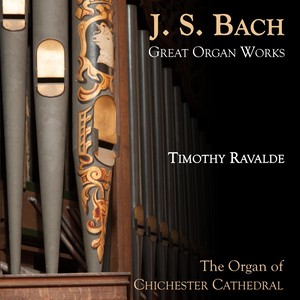
- 歌曲
- 时长
-
作曲家:Johann Sebastian Bach( 约翰·塞巴斯蒂安·巴赫)
-
作品集:Fantasia and Fugue in G Minor
-
作曲家:Johann Sebastian Bach( 约翰·塞巴斯蒂安·巴赫)
-
作品集:Prelude and Fugue in G Major
-
作品集:BWV 622
-
作曲家:Johann Sebastian Bach( 约翰·塞巴斯蒂安·巴赫)
-
作品集:Passacaglia in C Minor
-
作品集:BWV 621
-
作品集:Prelude and Fugue in B Minor
-
作曲家:Johann Sebastian Bach( 约翰·塞巴斯蒂安·巴赫)
-
作品集:BWV 664
-
作品集:BWV 540
简介
Timothy Ravalde is the Assistant Organist of Chichester Cathedral, where he is responsible for accompanying the daily choral services and assisting with the training of the Cathedral Choir. He has also accompanied the choir for three recordings, numerous BBC broadcasts, and on tour in Germany and Italy. He was educated at the Nelson Thomlinson School, Wigton, and has held organ scholarships at Carlisle and Salisbury Cathedrals. He graduated from Cambridge University, where he studied music, in 2010. As Organ Scholar of St John’s College he acted as assistant to Andrew Nethsingha, accompanying the college choir for numerous tours, the famous annual Advent broadcasts and three critically acclaimed CD recordings with Chandos, as well as the daily chapel services. He also acted as Musical Director of the St John’s Singers, the College’s mixed voice choir and won the 2009 Brian Runnett Prize for organ playing. The earliest references to an organ in Chichester Cathedral suggest that an instrument existed in the Lady Chapel in 1533. This was probably dismantled following damage caused by Cromwell’s troops, to be replaced in 1678 by a new one-manual organ built by one of the most famous organ builders of the day, Renatus Harris. A number of pipes from this instrument remain in the present day organ, including some of the richly decorated front pipes. The next two centuries saw various additions by John Byfield (the Choir Organ in 1725 or 1751, and a trumpet stop), Thomas Knight (a Swell Organ in 1778) and George Pike England, who added the organ’s first pedal department in 1806, putting Chichester amongst the first cathedrals in England to have pedals. Various tonal additions were made by Gray and Davison in 1844, and by William Hill in 1851. Throughout his long association with the organ, Hill was careful to re-use existing pipework as far as possible, an act of wise stewardship for which listeners today have reason to be grateful. For in 1861, the Cathedral’s central tower and spire dramatically collapsed. The organ, in its relatively recent position of the North Transept, suffered surprisingly modest damage, and was rebuilt in the 1880s, a rare survivor of the gentle, early English style of organ building, having escaped the large-scale extension and romanticisation found in many cathedral organs in the Victorian age. A further rebuild was carried out in 1904 by Hele, including the installation of tubular pneumatic action. By 1973, this was failing, and the organ had become so unreliable that it fell silent, until the major restoration of 1986 carried out by N. P. Mander Limited. Following the pattern of earlier work, this project preserved the historic pipework, provided new, mechanical action and enlarged the pedal department. The majestic front case, designed by Arthur Hill in 1888, was extended to the sides and back, and a new 5-stop solo organ was added, along with a nave section playable from its own console or the main console, to assist congregational singing in the nave. The organ’s future remains secure, supported in large part by the dedicated financial provision that exists as part of the ongoing work of the Chichester Cathedral Restoration and Development Trust.







